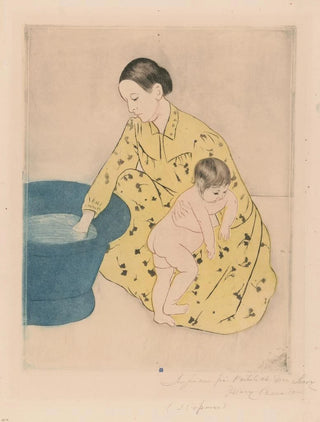Art print | The bath (Conflict of cases) - Mary Cassatt


View from behind

Frame (optional)
In the fascinating world of Impressionist art, the artwork "Le bain (Conflit de cas)" by Mary Cassatt stands out for its intimate and delicate portrayal of family relationships. This canvas, which depicts a scene from everyday life, captures a fleeting moment where tenderness and tension coexist. Cassatt's ability to immortalize an interaction between a mother and her child invites deep reflection on motherhood and human emotions. By contemplating this art print, the viewer is transported into the warm and complex universe of 19th-century domestic life, where each brushstroke seems to resonate with the sweetness of memories and the depth of emotional bonds.
Style and uniqueness of the artwork
Mary Cassatt's style, imbued with a unique sensitivity, is fully expressed in "Le bain (Conflit de cas)". The artist uses soft colors and rounded shapes to create an atmosphere that is both soothing and dynamic. The figures, although stylized, are highly expressive, revealing a subtle tension between the pleasure of the bath and the disagreements that can arise in family life. Cassatt diverges from the conventions of her time by choosing to depict scenes of everyday life, often centered on women and children. This innovative approach allows her to give voice to female experiences, often overlooked in traditional art. Thus, "Le bain (Conflit de cas)" becomes an ode to motherhood, highlighting the challenges and joys that accompany it.
The artist and her influence
Mary Cassatt, an emblematic figure of Impressionism, managed to establish herself in an artistic environment dominated by men. Born in 1844, she was influenced by the great European masters but also developed a style that is uniquely her own. Her friendship with Edgar Degas, another pillar of Impressionism, played a crucial role in her artistic evolution. Together, they explored similar themes, but Cassatt always knew how to bring her own vision, focused on the lives of women and children. Her work paved the way for a new understanding of female representation in art,

Matte finish

View from behind

Frame (optional)
In the fascinating world of Impressionist art, the artwork "Le bain (Conflit de cas)" by Mary Cassatt stands out for its intimate and delicate portrayal of family relationships. This canvas, which depicts a scene from everyday life, captures a fleeting moment where tenderness and tension coexist. Cassatt's ability to immortalize an interaction between a mother and her child invites deep reflection on motherhood and human emotions. By contemplating this art print, the viewer is transported into the warm and complex universe of 19th-century domestic life, where each brushstroke seems to resonate with the sweetness of memories and the depth of emotional bonds.
Style and uniqueness of the artwork
Mary Cassatt's style, imbued with a unique sensitivity, is fully expressed in "Le bain (Conflit de cas)". The artist uses soft colors and rounded shapes to create an atmosphere that is both soothing and dynamic. The figures, although stylized, are highly expressive, revealing a subtle tension between the pleasure of the bath and the disagreements that can arise in family life. Cassatt diverges from the conventions of her time by choosing to depict scenes of everyday life, often centered on women and children. This innovative approach allows her to give voice to female experiences, often overlooked in traditional art. Thus, "Le bain (Conflit de cas)" becomes an ode to motherhood, highlighting the challenges and joys that accompany it.
The artist and her influence
Mary Cassatt, an emblematic figure of Impressionism, managed to establish herself in an artistic environment dominated by men. Born in 1844, she was influenced by the great European masters but also developed a style that is uniquely her own. Her friendship with Edgar Degas, another pillar of Impressionism, played a crucial role in her artistic evolution. Together, they explored similar themes, but Cassatt always knew how to bring her own vision, focused on the lives of women and children. Her work paved the way for a new understanding of female representation in art,






